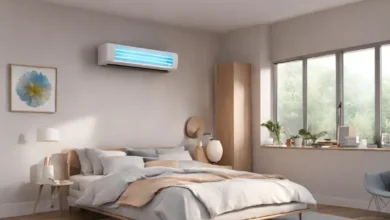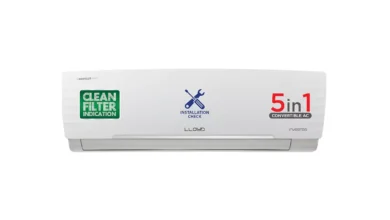Portable vs. Fixed Air Conditioning Solutions: Deciphering the Cooling Dilemma in India

In the blistering summer months across India, when the gentle hum of ceiling fans falls short, millions turn to air conditioning for relief. However, the array of air conditioner types available can leave consumers grappling with decisions. For those deliberating between portable air conditioners and split system air conditioners, a nuanced understanding of their pros and cons is essential. Let’s delve into the features, benefits, and considerations of each, shedding light on the dilemma faced by many Indian homeowners.
Also read: Best AC in India 2024
Portable Air Conditioners: Unleashing Mobility and Adaptability
What is a Portable Air Conditioner, and How Does it Work?
As the name implies, a portable air conditioner is a movable cooling unit, compact enough to shift from room to room as needed. With a size not much larger than a bedside table, these units often come equipped with a duct connected to the back, requiring a window connection.
The portable air conditioner draws in warm room air, dehumidifies and cools it, ready to circulate back into the room. Simultaneously, the hot air is expelled out through the window via the connected duct. Many portable units also boast the ability to dehumidify and even provide heating during the colder months.
Pros of Portable Air Conditioners
1. Mobility
The standout advantage of portable air conditioners is their mobility. Unlike fixed split system units, portables allow you to cool various rooms at different times. This flexibility also extends to storage; when not in use, these units can be conveniently stowed away, freeing up valuable floor space.
2. Unit Cost
Portable air conditioners come with a lower upfront cost, typically ranging from ₹30,000 to ₹60,000. This affordability makes them an attractive option for budget-conscious consumers.
3. No Installation Required
Ready to use out of the box, portable air conditioners spare homeowners from the need for professional installation. This not only saves on installation costs but also eliminates the waiting time associated with scheduling a professional setup.
Cons of Portable Air Conditioners
1. Low Power
While adequate for cooling small rooms, portable air conditioners typically range around 2kW, making them less powerful than their split system counterparts. Larger spaces might see a dip in effectiveness.
2. Low Energy Efficiency
In terms of energy efficiency, portable units tend to be less favorable, costing around ₹8 to ₹15 per hour to run. This inefficiency becomes noticeable when compared to more energy-efficient split system units.
3. Noisy Operation
Due to the compact design housing all components inside the room, portable air conditioners can be relatively noisy during operation, impacting indoor tranquility.
4. Uses Up Floor Space
While smaller in size, portable air conditioners still occupy floor space and require proximity to a window. This placement can necessitate furniture rearrangement, impacting room aesthetics.
Split System Air Conditioners: Power and Permanence
What is a Split System Air Conditioner, and How Does it Work?
The most prevalent air conditioner type in Indian homes, split system air conditioners consist of two components: the indoor unit (wall-mounted) and the outdoor unit. The indoor unit delivers cool air into the room, while the outdoor unit expels hot air generated during the cooling process.
Pros of Split System Air Conditioners
1. Energy Efficiency
Renowned for their energy efficiency, split system air conditioners tend to be more economical in the long run. Although the initial costs and installation expenses are higher, the ongoing running costs are comparatively lower.
2. High Powered Cooling
Offering robust cooling capabilities, split system units are suitable for larger spaces. Multi-split systems, with multiple indoor units connected to a single outdoor unit, provide even greater cooling power.
3. Space Saving Design
Designed to be wall-mounted, split system air conditioners save floor space and seamlessly integrate with room aesthetics.
4. Quiet Operation
Split system air conditioners operate quietly, with the noisier components housed in the outdoor unit. This ensures a peaceful indoor environment.
Cons of Split System Air Conditioners
1. Unit Cost
While energy-efficient, split system units come with a higher upfront cost, ranging from ₹30,000 to ₹1,20,000 or more, in addition to installation expenses.
2. Requires Professional Installation
Professional installation is mandatory for split system air conditioners. Attempting a DIY installation not only voids the warranty but can also result in inefficient operation.
3. Less Suitable for Renters
As wall-mounted units, split systems are less suitable for renters, requiring landlord approval for installation. Moreover, they are permanent fixtures and cannot be taken when moving.
4. Noisy Outdoor Unit
The outdoor unit of split system air conditioners can generate noise, which may be a concern in residential areas.
Choosing Between Portable and Split System Air Conditioners
While there’s no one-size-fits-all answer, split system air conditioners often emerge as the preferred choice due to their energy efficiency and high cooling power. However, for renters seeking flexibility and portability, portable air conditioners present a viable option. The decision hinges on individual needs, emphasizing the importance of considering factors like mobility, room size, upfront costs, and long-term efficiency.
Navigating the Space Dilemma: Fixed vs. Portable Air Conditioners
Fixed Air Conditioners: Space Considerations and Installation Challenges
Space Demands:
Opting for a fixed air conditioner mandates a clear wall for installation. In cases where multiple units are desired, ample wall space becomes a necessity. Furnished homes pose an additional challenge, requiring careful consideration of available space.
Installation Costs:
Choosing a fixed air conditioner involves factoring in installation costs. While not solely driven by budget constraints, this decision might be influenced by lifestyle choices. For individuals spending extended periods at home for work or study, the continuous cooling provided by fixed units is advantageous.
Quieter Performance:
Fixed air conditioners, being wall-mounted, not only offer better performance but also operate more quietly than their portable counterparts. This is especially beneficial for those requiring a calm environment for work or relaxation.
Portable Air Conditioners: Versatility and Cost-Effective Cooling
Space-Friendly Design:
Portable air conditioners, with their sleek and portable design, seamlessly integrate into home decor. Their adaptability makes them ideal for those unable to install fixed units due to space constraints.
Cost Considerations:
While less powerful than fixed air conditioners, portable units come with a lower price tag and no installation hassles. This makes them a cost-effective choice, especially for cooling specific rooms rather than the entire home.
Ventilation Challenges:
Portable air conditioners, despite their convenience, require external ventilation. This often involves placing the heat exchange tube out of a window, potentially impacting thermal insulation. However, this minor inconvenience is outweighed by the unit’s portability.
The Crucial Role of Refrigerants in Environmental Impact
Regardless of the chosen type—fixed or portable—a critical consideration is the environmental impact. Opting for air conditioners using eco-friendly refrigerants, such as R407C, R424A, R434A, or R410A, ensures a more sustainable choice. Among these, R410A stands
out for its minimal environmental harm, making it an ideal choice for domestic air conditioners.
Conclusion: Cooling Wisely in the Indian Summer
As the relentless Indian summer demands a reliable cooling solution, the choice between portable and split system air conditioners becomes pivotal. Each option comes with its set of advantages and drawbacks, necessitating careful consideration of individual needs and preferences. While split systems boast energy efficiency and robust cooling, portable units offer unparalleled mobility and cost-effective solutions. The decision ultimately hinges on factors like room size, mobility requirements, upfront costs, and long-term efficiency goals.
In conclusion, whether opting for the permanence of split system air conditioners or the adaptability of portable units, choosing wisely ensures a comfortable and energy-efficient oasis during the Indian summer. So, as the mercury rises, let thoughtful considerations guide your decision, ensuring you stay cool and comfortable in your home retreat.





